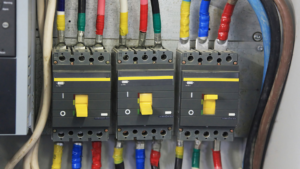 Knowing how to trip a circuit breaker isn’t essential for homeowners. Instead, if they’re experiencing an electrical issue or need to install, test, or repair electrical equipment, they need to know how to deactivate and reset a circuit breaker. Circuit breakers are safety devices designed to prevent overcurrent, electrical faults, and electrical fires. Each one contains a tripping mechanism, such as a magnet or bimetallic strip, connected to an operating lever.
Knowing how to trip a circuit breaker isn’t essential for homeowners. Instead, if they’re experiencing an electrical issue or need to install, test, or repair electrical equipment, they need to know how to deactivate and reset a circuit breaker. Circuit breakers are safety devices designed to prevent overcurrent, electrical faults, and electrical fires. Each one contains a tripping mechanism, such as a magnet or bimetallic strip, connected to an operating lever.
The lever is attached to a contact switch, which enables the flow of electricity. When the current exceeds the circuit’s maximum load (e.g. 15 amps), the tripping mechanism activates the handle, which flips the contact switch and separates the conductive material inside the circuit, cutting power to your home.
How to Trip a Circuit Breaker
It’s rare for circuit breakers to trip. Though they can be reset, breakers that trip frequently may be a sign of a serious issue with your home or electrical system, such as:
- Overloading. Occurs whenever the amount of power flowing through a circuit exceeds its maximum amperage. It’s the most common reason circuits trip, normally because too many appliances have been plugged into the same circuit. For this reason, when a breaker trips, the best course of action is to unplug one or more appliances and then reset it. In most cases, that will solve the problem.
- Electrical Short. When a hot wire carrying electricity comes into contact with a neutral wire returning electricity to the grid, it creates a low-resistance pathway that accelerates the flow of electricity. Unless it’s repaired, it can burn out your appliances and electrical system, or overheat and start a fire. Shorts are normally caused by frayed insulation, faulty components, poor installation, or moisture.
Intentionally tripping a circuit breaker is unsafe. It can not only harm your home, but may even lead to injury or cause an electrical fire. In the event you need to cut power to your house, here are the steps you’ll need to follow.
How to Deactivate a Circuit Breaker
Electrical wiring can be dangerous, even for a professional. Always disable the current before working on your power system. First:
- Locate your breaker box. It’s normally located in the attic, basement, or garage, though in some homes, it may be located outside.
- Identify the right circuit. Every circuit breaker in your home should be labeled, so you know exactly which part of your home it controls. If they aren’t, you will have to shut each one off individually, then go through your home until you find the one you want.
- Deactivate the breaker. Circuit breakers are controlled by a simple switch. To cut power, simply move it from “ON” to “OFF.”
- Test the circuit. Use a voltage tester to make certain the circuit is completely dead. If current is still flowing, you have a problem with your breaker box. Call an electrician to diagnose and resolve the problem.
- Restore Power. Once you’ve finished working, return to the breaker box and reactivate the circuit. Everything connected to it should power on like normal.
Always be cautious when working with electrical wires or devices. Unless you have electrical experience or training, it’s best to call a contractor for assistance with maintenance and installation.
Save on Electrical Repairs with Agway
Like every other part of your house, internal wiring is subject to wear and tear. As wires age, corrosion, loose connections, and worn insulation can degrade their performance. Tripped circuit breakers are often one of the signs wiring needs to be repaired or upgraded. And while home insurance won’t cover this type of damage, Agway will.
Our EnergyGuardTM program protects your heating, cooling, and electrical systems.* When the need for repair occurs, our customers don’t have to worry about finding a qualified technician. Our service team maintains an extensive network of local contractors, so help reaches you quickly. There are no service fees or deductibles either. We pay for the visit and all covered parts. Don’t wait. Join Agway and start enjoying the benefits of EnergyGuardTM today!
*Coverage depends on which commodity you purchase.